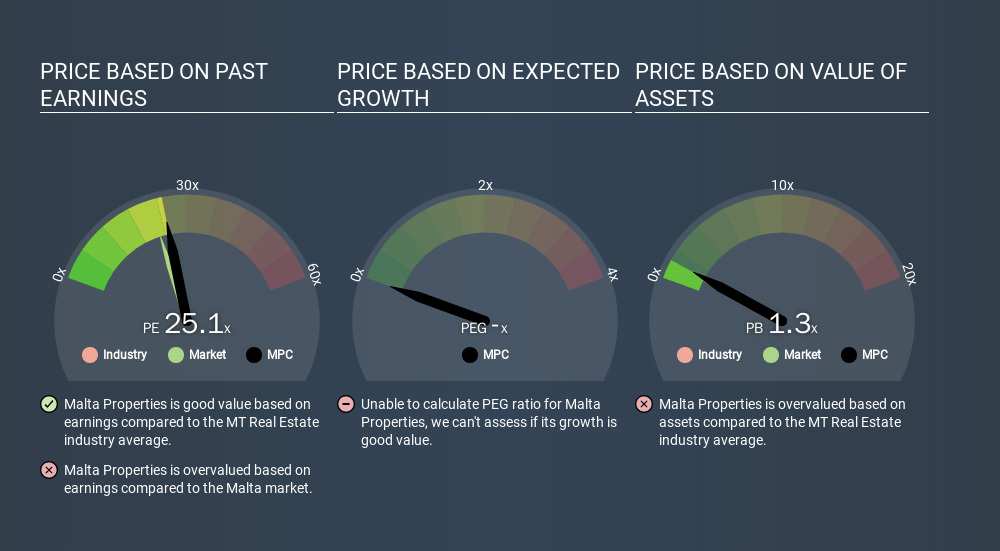- Malta
- /
- Real Estate
- /
- MTSE:MPC
Despite Its High P/E Ratio, Is Malta Properties Company p.l.c. (MTSE:MPC) Still Undervalued?
Today, we'll introduce the concept of the P/E ratio for those who are learning about investing. We'll show how you can use Malta Properties Company p.l.c.'s (MTSE:MPC) P/E ratio to inform your assessment of the investment opportunity. Based on the last twelve months, Malta Properties's P/E ratio is 25.07. That is equivalent to an earnings yield of about 4.0%.
See our latest analysis for Malta Properties
How Do I Calculate A Price To Earnings Ratio?
The formula for price to earnings is:
Price to Earnings Ratio = Price per Share ÷ Earnings per Share (EPS)
Or for Malta Properties:
P/E of 25.07 = EUR0.67 ÷ EUR0.03 (Based on the trailing twelve months to December 2019.)
Is A High Price-to-Earnings Ratio Good?
A higher P/E ratio implies that investors pay a higher price for the earning power of the business. All else being equal, it's better to pay a low price -- but as Warren Buffett said, 'It's far better to buy a wonderful company at a fair price than a fair company at a wonderful price'.
How Does Malta Properties's P/E Ratio Compare To Its Peers?
The P/E ratio indicates whether the market has higher or lower expectations of a company. The image below shows that Malta Properties has a P/E ratio that is roughly in line with the real estate industry average (25.1).

Malta Properties's P/E tells us that market participants think its prospects are roughly in line with its industry. So if Malta Properties actually outperforms its peers going forward, that should be a positive for the share price. Checking factors such as director buying and selling. could help you form your own view on if that will happen.
How Growth Rates Impact P/E Ratios
P/E ratios primarily reflect market expectations around earnings growth rates. When earnings grow, the 'E' increases, over time. And in that case, the P/E ratio itself will drop rather quickly. And as that P/E ratio drops, the company will look cheap, unless its share price increases.
Malta Properties saw earnings per share decrease by 75% last year. But EPS is up 1.7% over the last 3 years. And over the longer term (5 years) earnings per share have decreased 71% annually. This growth rate might warrant a below average P/E ratio.
Remember: P/E Ratios Don't Consider The Balance Sheet
It's important to note that the P/E ratio considers the market capitalization, not the enterprise value. Thus, the metric does not reflect cash or debt held by the company. The exact same company would hypothetically deserve a higher P/E ratio if it had a strong balance sheet, than if it had a weak one with lots of debt, because a cashed up company can spend on growth.
While growth expenditure doesn't always pay off, the point is that it is a good option to have; but one that the P/E ratio ignores.
Is Debt Impacting Malta Properties's P/E?
Malta Properties's net debt is 21% of its market cap. That's enough debt to impact the P/E ratio a little; so keep it in mind if you're comparing it to companies without debt.
The Verdict On Malta Properties's P/E Ratio
Malta Properties trades on a P/E ratio of 25.1, which is above its market average of 22.5. With modest debt but no EPS growth in the last year, it's fair to say the P/E implies some optimism about future earnings, from the market.
Investors should be looking to buy stocks that the market is wrong about. If the reality for a company is better than it expects, you can make money by buying and holding for the long term. We don't have analyst forecasts, but you could get a better understanding of its growth by checking out this more detailed historical graph of earnings, revenue and cash flow.
Of course you might be able to find a better stock than Malta Properties. So you may wish to see this free collection of other companies that have grown earnings strongly.
If you spot an error that warrants correction, please contact the editor at editorial-team@simplywallst.com. This article by Simply Wall St is general in nature. It does not constitute a recommendation to buy or sell any stock, and does not take account of your objectives, or your financial situation. Simply Wall St has no position in the stocks mentioned.
We aim to bring you long-term focused research analysis driven by fundamental data. Note that our analysis may not factor in the latest price-sensitive company announcements or qualitative material. Thank you for reading.
About MTSE:MPC
Malta Properties
Engages in the investment and development of commercial properties in Malta.
Medium-low risk unattractive dividend payer.
Market Insights
Community Narratives



